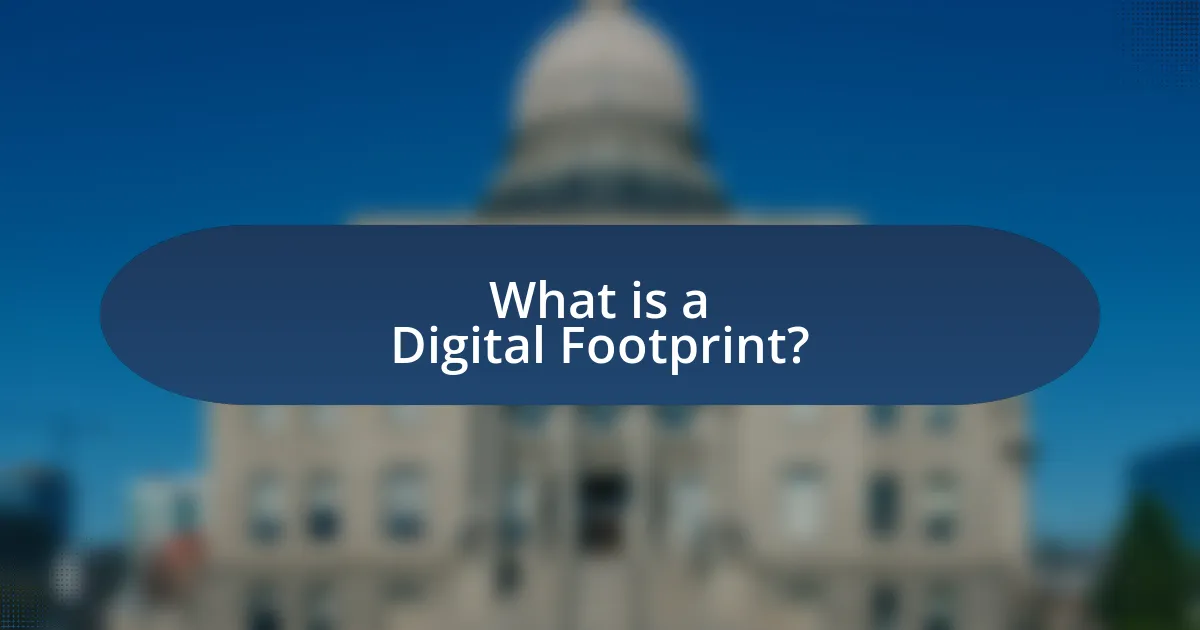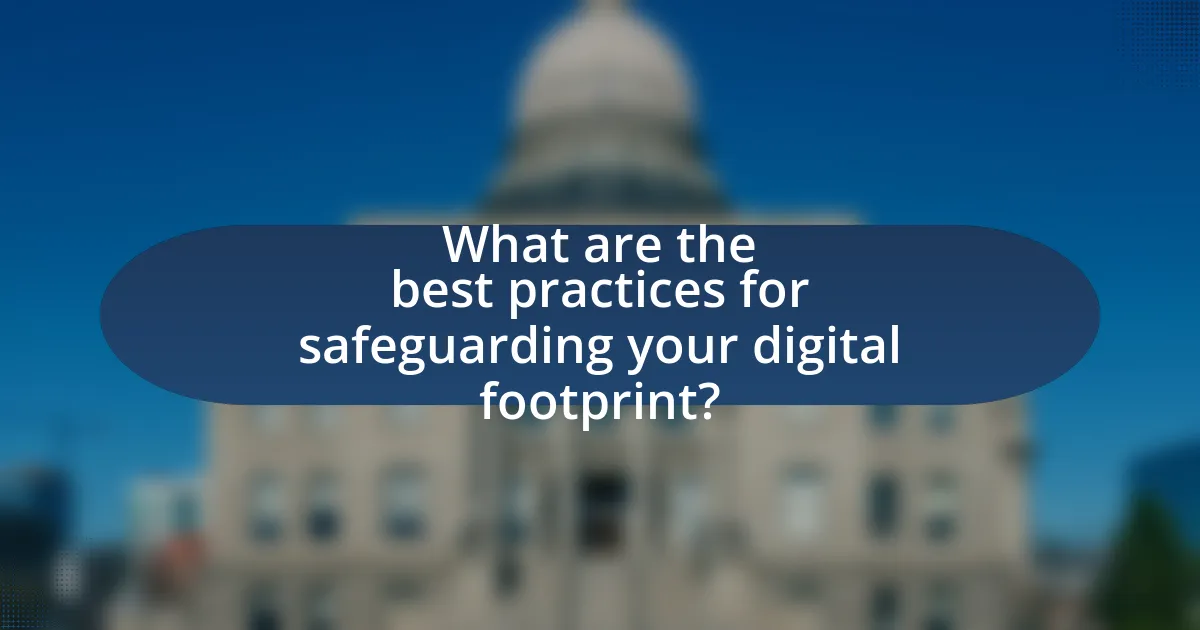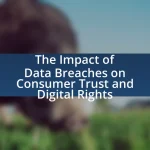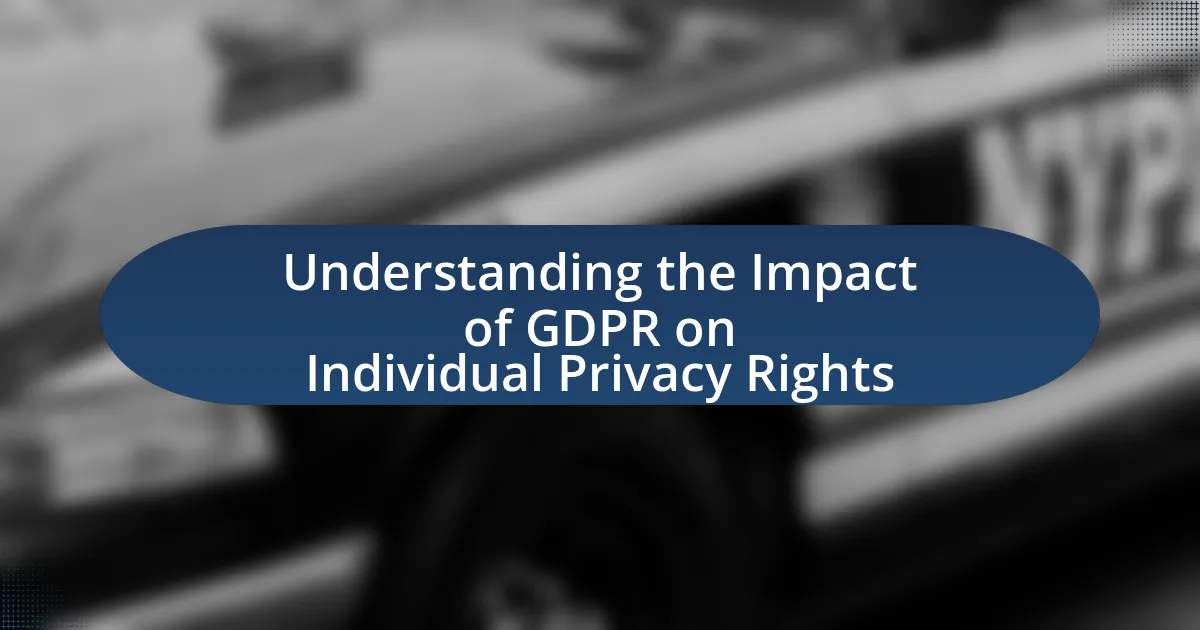A digital footprint refers to the data trail individuals leave behind while using the internet, which includes both active contributions like social media posts and passive data collection such as browsing history. This article outlines the creation and implications of digital footprints, emphasizing the importance of managing them to protect personal privacy and security. Key topics include the types of online activities that contribute to a digital footprint, the risks associated with an unmanaged footprint, and best practices for safeguarding personal information. Additionally, the article provides practical tips for minimizing digital footprints and managing privacy settings effectively across various online platforms.

What is a Digital Footprint?
A digital footprint is the trail of data that individuals leave behind when they use the internet, encompassing both active contributions, such as social media posts and comments, and passive data collection, such as browsing history and cookies. This footprint can be categorized into two types: the active digital footprint, which includes information users intentionally share, and the passive digital footprint, which consists of data collected without user knowledge, such as IP addresses and location data. According to a study by the Pew Research Center, 90% of internet users are concerned about their digital footprint, highlighting the importance of understanding and managing this data to protect personal privacy and security.
How is a digital footprint created?
A digital footprint is created through the online activities and interactions of an individual, including website visits, social media usage, online purchases, and email communications. Each time a user engages with digital platforms, data is collected and stored, contributing to their digital footprint. For instance, browsing history, cookies, and account registrations generate data that can be tracked and analyzed, illustrating user behavior and preferences. According to a study by the Pew Research Center, 90% of Americans are concerned about their online privacy, highlighting the significance of understanding how digital footprints are formed and the potential implications for personal privacy.
What types of online activities contribute to a digital footprint?
Online activities that contribute to a digital footprint include social media interactions, online shopping, web browsing, email communication, and participation in forums or blogs. Each of these activities generates data that can be tracked and stored, such as posts, likes, purchases, search history, and comments. For instance, a study by the Pew Research Center indicates that 70% of adults in the U.S. use social media, which significantly increases their digital footprint through shared content and interactions.
How do social media interactions affect your digital footprint?
Social media interactions significantly shape your digital footprint by creating a permanent record of your online behavior and preferences. Each post, comment, like, or share contributes to a profile that companies and algorithms use to analyze your interests and habits. For instance, a study by Pew Research Center found that 70% of social media users have adjusted their privacy settings to control who can see their content, highlighting the awareness of how interactions can influence personal data visibility. This accumulation of data can lead to targeted advertising, personalized content, and even affect job opportunities, as employers often review candidates’ social media profiles. Thus, the nature and frequency of your interactions on social media directly impact the breadth and depth of your digital footprint.
Why is it important to safeguard your digital footprint?
Safeguarding your digital footprint is crucial because it protects your personal information from misuse and potential harm. A digital footprint comprises all the data you leave online, which can be exploited by cybercriminals for identity theft, fraud, or harassment. According to a 2021 report by Cybersecurity Ventures, cybercrime is projected to cost the world $10.5 trillion annually by 2025, highlighting the significant risks associated with inadequate digital security. By actively managing and protecting your digital footprint, you reduce the likelihood of becoming a victim of these crimes and maintain control over your online identity.
What risks are associated with an unmanaged digital footprint?
An unmanaged digital footprint poses significant risks, including identity theft, privacy invasion, and reputational damage. Identity theft can occur when personal information, such as social security numbers or financial details, is exposed online, leading to unauthorized access to accounts. Privacy invasion happens when sensitive data is collected and misused by third parties, often without the individual’s consent. Reputational damage arises from negative content or misinformation that can spread rapidly online, impacting personal and professional relationships. According to a 2021 report by the Identity Theft Resource Center, there were over 1,800 data breaches in the U.S., exposing millions of records, highlighting the critical need for managing one’s digital footprint effectively.
How can a digital footprint impact personal and professional life?
A digital footprint can significantly impact both personal and professional life by influencing reputation and opportunities. Personal life is affected as online activities, such as social media posts and search history, can shape perceptions among friends and family, potentially leading to social consequences or strained relationships. Professionally, employers often review candidates’ digital footprints during hiring processes; a negative online presence can result in lost job opportunities. According to a survey by CareerBuilder, 70% of employers use social media to screen candidates, highlighting the importance of maintaining a positive digital image. Thus, managing one’s digital footprint is crucial for safeguarding both personal relationships and career prospects.

What are the best practices for safeguarding your digital footprint?
To safeguard your digital footprint, implement strong privacy settings across all online accounts. This includes using complex passwords, enabling two-factor authentication, and regularly reviewing privacy settings on social media platforms. According to a 2021 study by the Pew Research Center, 81% of Americans feel they have little to no control over the data collected about them, highlighting the importance of proactive measures. Additionally, be cautious about sharing personal information online and consider using privacy-focused tools such as VPNs and encrypted messaging apps to further protect your data.
How can you manage your privacy settings on social media?
To manage your privacy settings on social media, access the privacy or security section of your account settings. Most platforms, such as Facebook, Twitter, and Instagram, provide options to control who can see your posts, who can send you friend requests, and what personal information is visible to others. For example, Facebook allows users to customize their audience for posts and limit profile visibility to friends only. Regularly reviewing these settings is essential, as platforms frequently update their privacy policies and features, which can affect your privacy.
What specific settings should you adjust to enhance privacy?
To enhance privacy, adjust the following specific settings: enable two-factor authentication, limit location sharing, and review app permissions. Two-factor authentication adds an extra layer of security by requiring a second form of verification, significantly reducing unauthorized access. Limiting location sharing prevents apps from tracking your movements, which can protect sensitive information. Reviewing app permissions ensures that applications only have access to necessary data, minimizing exposure to potential data breaches. These adjustments collectively strengthen your digital privacy by controlling access to personal information.
How often should you review your privacy settings?
You should review your privacy settings at least once every three to six months. Regular reviews help ensure that your settings align with any changes in privacy policies, platform updates, or personal circumstances. According to a study by the Pew Research Center, 64% of Americans have experienced a major data breach, highlighting the importance of staying vigilant about privacy settings to protect personal information.
What tools and software can help protect your digital footprint?
Tools and software that can help protect your digital footprint include Virtual Private Networks (VPNs), privacy-focused web browsers like Brave, and password managers such as LastPass. VPNs encrypt internet traffic, making it difficult for third parties to track online activities. Privacy-focused browsers block trackers and ads, enhancing user anonymity. Password managers securely store and generate complex passwords, reducing the risk of account breaches. These tools collectively contribute to minimizing exposure and safeguarding personal information online.
Which antivirus programs are recommended for safeguarding online activity?
Recommended antivirus programs for safeguarding online activity include Norton, Bitdefender, and Kaspersky. Norton offers comprehensive protection with features like real-time threat detection and a secure VPN, making it effective for online safety. Bitdefender is known for its advanced malware protection and anti-phishing capabilities, which are crucial for secure browsing. Kaspersky provides robust security features, including a strong firewall and privacy protection tools, ensuring safe online transactions. These programs are consistently rated highly by independent testing labs, confirming their effectiveness in protecting users’ digital footprints.
How do VPNs contribute to protecting your digital footprint?
VPNs contribute to protecting your digital footprint by encrypting your internet connection and masking your IP address. This encryption prevents third parties, such as hackers and advertisers, from intercepting your online activities and personal information. By routing your internet traffic through a secure server, VPNs make it difficult for websites and services to track your browsing habits and location, thereby enhancing your privacy. Studies indicate that using a VPN can significantly reduce the risk of data breaches and identity theft, as it adds an additional layer of security to your online presence.

What steps can you take to minimize your digital footprint?
To minimize your digital footprint, you should regularly review and adjust your privacy settings on social media platforms and online accounts. This action limits the amount of personal information shared publicly. Additionally, you can delete unused accounts and opt out of data collection services, which reduces the data available about you online. Using privacy-focused search engines and browsers can further enhance your anonymity. According to a study by the Pew Research Center, 81% of Americans feel they have little to no control over the data collected about them, highlighting the importance of proactive measures in managing one’s digital presence.
How can you limit the information you share online?
To limit the information you share online, adjust your privacy settings on social media platforms and refrain from posting personal details. Social media platforms like Facebook and Instagram allow users to customize their privacy settings, enabling them to control who can see their posts and personal information. According to a 2021 Pew Research Center study, 81% of Americans feel they have little to no control over the data collected about them online, highlighting the importance of actively managing privacy settings to safeguard personal information. Additionally, avoid sharing sensitive information such as your address, phone number, or financial details in public forums or unsecured websites, as this can lead to identity theft and other privacy breaches.
What types of information should you avoid sharing publicly?
You should avoid sharing personally identifiable information, financial details, and sensitive personal data publicly. Personally identifiable information includes your full name, address, phone number, and Social Security number, which can be used for identity theft. Financial details such as bank account numbers, credit card information, and passwords can lead to financial fraud. Additionally, sensitive personal data like medical records or private correspondence can compromise your privacy and security. Sharing this type of information increases the risk of exploitation and breaches of privacy.
How can you delete old accounts and data from the internet?
To delete old accounts and data from the internet, individuals should first identify all accounts associated with their email addresses or usernames. This can be done by checking email inboxes for account confirmation messages or using services like JustDelete.me, which provides links to delete accounts from various websites. After identifying the accounts, users should visit each website and follow the specific account deletion process, which often involves navigating to account settings and selecting the option to delete or deactivate the account.
Additionally, users should request the removal of personal data from data broker sites, such as Whitepages or Spokeo, which often aggregate personal information. Many of these sites provide opt-out instructions. According to a 2021 report by the Privacy Rights Clearinghouse, over 70% of Americans have online accounts they no longer use, highlighting the importance of actively managing digital footprints.
What are the common mistakes to avoid when managing your digital footprint?
Common mistakes to avoid when managing your digital footprint include oversharing personal information, neglecting privacy settings, and failing to regularly monitor online presence. Oversharing can lead to identity theft or unwanted attention, as studies show that 60% of social media users do not adjust their privacy settings, exposing themselves to risks. Neglecting privacy settings allows third parties to access personal data, which can be exploited. Regularly monitoring online presence is crucial; research indicates that 70% of employers check candidates’ online profiles, making it essential to maintain a professional image.
How can oversharing lead to a compromised digital footprint?
Oversharing can lead to a compromised digital footprint by providing excessive personal information that can be exploited by malicious actors. When individuals share details such as their location, daily routines, or sensitive personal data on social media or other online platforms, they create opportunities for identity theft, stalking, or fraud. For instance, a study by the Pew Research Center found that 64% of Americans have experienced some form of data exposure due to oversharing, highlighting the risks associated with revealing too much online. This behavior not only diminishes privacy but also increases vulnerability to cyber threats, ultimately compromising one’s digital footprint.
What are the consequences of ignoring digital footprint management?
Ignoring digital footprint management can lead to severe privacy breaches and reputational damage. When individuals fail to monitor their online presence, sensitive information may be exposed, making them vulnerable to identity theft, cyberbullying, and phishing attacks. According to a 2020 report by the Identity Theft Resource Center, over 1.1 million cases of identity theft were reported in the United States alone, highlighting the risks associated with unmanaged digital footprints. Furthermore, employers increasingly review candidates’ online profiles; negative or inappropriate content can result in lost job opportunities. A study by CareerBuilder found that 70% of employers use social media to screen candidates, emphasizing the importance of maintaining a positive digital image.
What practical tips can you implement today to safeguard your digital footprint?
To safeguard your digital footprint, start by reviewing and adjusting your privacy settings on social media platforms. This action limits the amount of personal information visible to others, reducing the risk of identity theft and unwanted exposure. Additionally, regularly updating your passwords and using strong, unique passwords for different accounts can significantly enhance your security. According to a study by the Cybersecurity & Infrastructure Security Agency, 81% of data breaches are linked to weak or stolen passwords. Furthermore, consider using a virtual private network (VPN) when accessing public Wi-Fi, as this encrypts your internet connection and protects your data from potential hackers. Implementing these practical tips today can effectively help you manage and protect your digital footprint.





